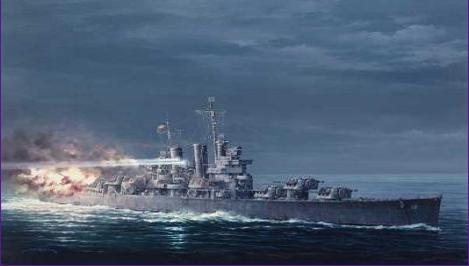
USS Helena (CL-50). Nothing "Light" about the Helena. Tough, hard fighter she was - with a lot to fire with.
Armament :Yes kiddies - that is 15 6" guns and 8 5" guns. The Japanese (who if nothing else in WWII had no problem honoring a good fighter) said she had "6-inch machine guns."
5 - Triple 6"/47 main battery
4 - Dual 5"/38 DP secondary
8 - .50 caliber AA
4 - Curtiss SOC-2 Seagulls (Aircraft) on 2 Aft catapults.
Read all about her here - but let's look at her final battle, the Battle of Kula Gulf.
BackgroundCatch that last bit? For the want of one well place 5" round .....
On 5 July, Task Group 36.1, commanded by Rear Admiral Walden L. Ainsworth, and consisting of light cruisers USS Helena, USS Honolulu, and USS St. Louis, plus four destroyers, had received word of another Tokyo Express run down "the Slot", and proceeded northwest past New Georgia.
The Allies were in the process of launching their next offensive in the Solomon Islands, having just landed troops on the island of Rendova as a preliminary step in seizing the major Japanese airstrip at Munda on New Georgia. In support of this landing, which was to set up an initial beachhead for moving U.S. troops across Blanche Channel to New Georgia, Ainsworth had the night before conducted a cruiser bombardment of Vila on Kolombangara and Bairoko on New Georgia and, short on fuel and ammunition, was in the process of retiring to the Coral Sea to replenish. A Marine landing was scheduled on the north shore of New Georgia on 10 July and would require further support.
Battle
At 01:06 off Kolombangara, the task group came into contact with a Japanese reinforcement group commanded by Admiral Teruo Akiyama which consisted of ten destroyers loaded with 2,600 combat troops, bound for Vila, which they used as a staging point for movement into Munda. The Japanese were divided into two forces, and a formation of three escorts trailing the main column first came under attack.
The U.S. ships opened fire at 01:57 and quickly sank the destroyer Niizuki and killed Admiral Akiyama. However the Helena had expended all its flashless powder the night before and was forced to use smokeless, illuminating itself to the Japanese ships with every salvo. Two of the Japanese destroyers launched their Long Lance torpedoes and sank Helena. The main Japanese force, which had countermarched away from Vila with the first contact, broke away having landed only 850 of the 2,600 troops. Nagatsuki ran aground, while Hatsuyuki was damaged.
Both forces began to withdraw from the area, but one Japanese and two U.S. destroyers remained in the area to rescue survivors and, at about 05:00, Japanese destroyer Amagiri and USS Nicholas exchanged torpedoes and gunfire. Amagiri was hit and retired. The beached Nagatsuki, abandoned by her crew in the morning, was bombed and sunk by U.S. planes.
Aftermath
USS Radford and Nicholas both stayed behind to rescue survivors from Helena. While rescuing over 750 men, Radford and Nicholas had to reengage the enemy three times and were awarded the Presidential Unit Citation for their rescue. Amagiri escaped and later was the ship that cut PT-109 in half in Blackett Strait southwest of Kolombangara.
As a side-bar for you GRAF SPEE fans, here and here you can see where HELENA's crew had a chance to photograph the hulk during her visit to the River Platte during her shakedown cruise.

First posted April 2009.









No comments:
Post a Comment